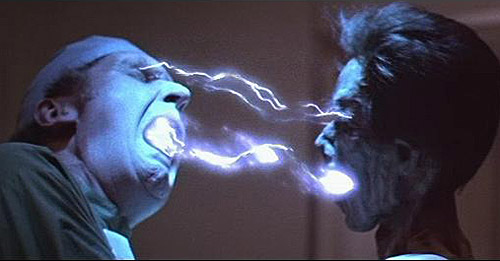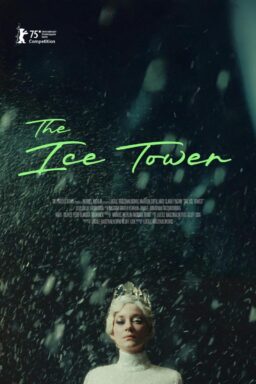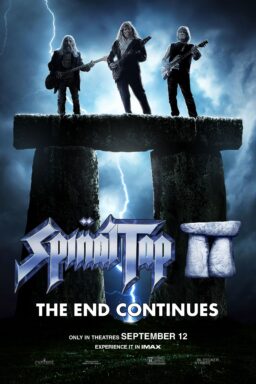Released in the summer of 1985 to critical scorn and near-total commercial indifference, the sci-fi/horror hybrid “Lifeforce” has spent most of the following 28 years languishing in obscurity. If it was remembered at all, it was either because of its massive financial failure–which helped doom the futures of both its producing company and its director–or because of its status as one of the all-time favorite films of Mr. Skin, that beloved repository of on-screen nudity.

However, in an unexpected turn of events as crazy as anything seen in the movie itself, “Lifeforce” seems to be on the verge of a full-fledged revival this year. After having been previously available only as a shabby-looking, bare-bones DVD, it will be making its Blu-Ray debut this April. More surprising, it was selected by Chicago’s beloved Music Box Theatre as part of its two-week festival of movies shot in 70mm, the large-sized film format offering nearly twice the resolution of the standard 35mm, alongside such esteemed works as “2001: A Space Odyssey,” “Playtime” and “The Master.” For some people, the very idea of playing what is essentially an expensive exploitation film alongside the likes of Kubrick and Tati may sound like madness but as far as I am concerned, this is the long-awaited moment in which an underrated cinema classic–albeit one of the decidedly crackpot variety–finally gets its chance to be admitted into the pantheon.
As the film opens, the space shuttle Churchill, manned by a joint U.S.-British crew, is investigating Halley’s Comet (which was heading towards Earth around the time this was being made) when they discover what appears to be a 150-mile-long spacecraft hidden in its tail. During a search of the derelict ship, the crew discovers some bat-like creatures and a trio of naked humanoids–two male and one very female (Mathilda May)–in suspended animation inside odd crystal-like chambers. The astronauts take the three chambers back to the shuttle because hey, what could possibly go wrong?

Thirty days later, having lost all contact with the shuttle, the ESA mounts a rescue mission but when they arrive, all they find are the charred remains of the crew, a missing escape pod and the three aliens still sleeping in their chambers. They bring the aliens back to London for study but while officials are dickering over if they are technically dead enough to justify an autopsy (“You would agree they are less alive than we are.”), the female suddenly wakes up, and gives the nearest doctor a kiss that leaves him a desiccated husk, before walking away, still naked as the day she was spawned.

Despite the crack security measures in place (“A naked girl is not going to get out of this complex”), she disappears into the night. As more dried-up bodies begin turning up, the authorities struggle to figure out what she is and what she wants. Their questions are answered when the Churchill’s missing escape pod lands in Texas containing its only survivor, Col. Tom Carlsen (Steve Railsback), who frantically informs them that the alien is a sort of vampire who feeds not on blood but on energy (from the “energy center” located just a couple of inches below the heart) and whose victims need to do the same in order to keep going themselves.
Carlsen knows all of this due to a psychic connection that he has developed with the female alien that allows him to see and feel what she does. Sadly, this ability does not allow him to realize that he is being sent on a wild goose chase to an out-of-the-way asylum where she appears to be inhabiting the body of a doctor (Patrick Stewart). By the time he finally figures out the ruse and discovers her ultimate purpose, London has devolved into chaos as the ever-expanding hordes of creatures stagger through the streets looking for new victims and beaming the energy they collect up to their ship via the altar at St. Paul’s Cathedral. (Not surprisingly, St. Paul’s Cathedral no longer lists this film on its resume).
Based on the above description, “Lifeforce” may sound like a a typical genre film but no mere recitation of plot details can begin to convey the sheer craziness that permeates virtually every scene. Simply put, this is one of the flat-out looniest movies ever produced, especially on this size and scale. Imagine the fever dream of an adolescent boy obsessed with sci-fi and in the early throes of his fascination and fear of the opposite sex and you might begin to get a grasp on what is in store, though most of you probably would not have included a weirdly rousing Henry Mancini score into the mix.
Although it starts off conventionally enough, things go quickly and delightfully sideways once the aliens are brought to Earth and accidentally set free. The level of disconnect between the lurid goings-on involving the naked aliens who leave their victims looking like comic-book ghouls and the maddening passivity of the British officials is astonishing. Events that suggest a cross between an old E.C. comic book and a copy of Penthouse Forum are playing out before their eyes and yet none of them remain anything other than utterly unflappable. Even when bewitched by the female creature, one doctor still musters up enough reserve when the “v” word comes up to offer up the deathless sentiment, “In a sense, we are all vampires. The difference is in the degree.” (Fun fact: although this particular role was played by Frank Finlay, it was originally meant to be portrayed by none other than Klaus Kinski, an actor whose madness was custom-made for a film like this.)
As nutty as it is so far, “Lifeforce” truly goes bonkers once its putative American hero finally crashes to Earth and into the story. While the British are all polite restraint, Carlsen comes across as someone who belongs in restraints. Snarling, shrieking and howling almost from the start, he starts off approximately where Jack Nicholson left off in “The Shining” and goes from there in ways that would seem excessive for someone playing a barking loon, let alone one playing the nominal hero. In terms of weirdness, he proves to be just as infectious as the creatures he is pursuing–before long, even the staid Brits are chewing the scenery as well (with Patrick Stewart being the best or the worst of the bunch, depending on one’s perspective).
Who is to be praised or blamed for this unique handling of what might have otherwise come across as just an uninspired combination of elements lifted from such genre favorites as “Planet of the Vampires” and “Alien” is hard to determine. Having been unsuccessful in my attempt to make it through the 1976 Colin Wilson novel (published under the title “The Space Vampires”), I cannot vouch for how closely the film sticks to the story or style of the original source material but I have a sneaky suspicion that there is not much in the way of correlations between them. Screenwriters Dan O'Bannon and Don Jakoby had shown a bent sense of humor and a taste for outrage in their other efforts (especially O’Bannon, whose credits include the screenplays for the original “Alien” and the satires “Dark Star” and “Return of the Living Dead”) but it is said that some of their work was changed and that they were not pleased with the results (especially the stuff involving Haley’s comet.)
In fact, if one is to ascribe the bizarro tone of “Lifeforce” to any one person, it almost certainly has to go to director Tobe Hooper, the man who landed himself a place in the Horror Hall of Fame with his infamous 1974 debut “The Texas Chain Saw Massacre,” a film that so thoroughly upended the traditions of the genre while spiking the proceedings with jet-black humor that it is one of the few avowed classics of the form to still retain the power to unnerve viewers to this very day. In the wake of that film’s success, Hooper had a somewhat uneven career until he was tapped by Steven Spielberg to direct the ghost story “Poltergeist.” To this day, there are still questions about whether or not Spielberg took control of that film’s direction–though it is far more conventional than the rest of Hooper’s output–but the end result was a hit that established finally established Hooper as a commercially viable filmmaker.
As a result, he received a three-film contract with the then-fledgling Cannon Group, who were trying to corner the world film market with an odd combination of art films from the likes of Zeffirelli with low-rent action fodder featuring Charles Bronson and Chuck Norris, with “Lifeforce” as an early project. Working with a hefty budget and without the whip hand of a creatively imposing producer, Hooper wound up producing a well-financed version of the kind of crackpot filmmaking that he established himself with in the first place. Having been given a crazy story to work with, Hooper clearly decided that the only way to deal with it was to match nutty with nutty and the result is the kind of movie where you keep thinking that it can’t possibly get any stranger and then it proceeds to do just that.
For example, while most movies of this type might have introduced a naked female creature into the proceedings and then either given her clothes or gone the “Austin Powers” route to avoid showing any naughty bits, Hooper has Mathilda May let it all hang out to such a degree throughout that whoever had the job of preparing a version of the film for broadcast on commercial television must have clocked in a lot of overtime. Then there are the scenes that so completely flout the bounds of convention that they boggle the mind–mine comes when Carlsen tries to psychically extract information from a woman and discovers that she is “an extreme masochist” who wants him to slap her around a bit before giving anything up. (That part is immediately topped when, warned that he should leave the room before the slapping begins, his British colleague pulls up a chair and dryly remarks “After all, I am a natural voyeur.”) Hell, the state of the mental health of “Lifeforce” can pretty much be determined by the fact that the closest thing it has to a hero is played by the guy best known for portraying Charles Manson in “Helter Skelter.”
At the same time, there are plenty of other reasons to enjoy “Lifeforce” in addition to all the craziness. Although it is tempting to portray most horror films from the late 1980’s on–especially ones involving vampires–as metaphors for AIDS, such connections are remarkably blatant here, remarkably so considering that the movie was being released just at the time that the disease was finally beginning to penetrate into the mainstream. From a technical standpoint, the movie is never less than impressive thanks to the inspired special effects courtesy of the legendary John Dykstra–even though some of them may look a little cartoonish today, they oddly help contribute to the hallucinatory nature of the proceedings. And if nothing else, even detractors of “Lifeforce” have to admit that the final half-hour is pretty spectacular as London descends into chaos before a climax so cheerfully bewildering that it makes the final minutes of “The Black Hole” seem staid by comparison.
Alas, not many moviegoers responded to the charms of “Lifeforce” (a title that Cannon decided on at the last second because they felt “The Space Vampires” sounded too cheesy), critics by and large assailed it, audiences ignored it in order to again bask in the glories of “Rambo” and it was yanked from theaters in a couple of weeks. More than just a flop, it proved to be a career killer for practically everyone involved with it. None of its stars ever quite recovered from its failure (Mathilda May, who was supposed to be its breakout star, is now said to leave it off her filmography) and Hooper, following the failures of his other two films for Cannon (a woeful remake of “Invaders from Mars” and his brilliant “Texas Chain Saw Massacre 2,” a film that works as a classic gorefest and one of the funniest bits of cinematic political satire of its age), went back into low-budget obscurity where he remains to this day. As for Cannon, the failure of “Lifeforce” was just one in a series of financial body blows that would lead to their bankruptcy by the end of the decade.
Nevertheless, “Lifeforce” survives and, as far as I am concerned, it plays much better today than most genre films of its time, not to mention those being produced today. It may be tasteless and lurid and demented beyond belief but, I for one, would take its glorious excesses over the turgid ones offered up by Peter Jackson”s apparently-never-ending take on “The Hobbit” in a heartbeat. Now that enough time has passed since its initial failure, perhaps it will now finally be able to attract the audience that it has always deserved. Whether these viewers see it at home on Blu-Ray or on the big screen in its 70mm glory, it is guaranteed to be an experience that they will never forget (though whether this is a good or bad thing will probably vary from person to person).
“Lifeforce” will show as part of the 70mm Film Festival at the Music Box Theatre on February 20 and 23 and will be released on Blu-Ray through Shout! Factory on April 30.












